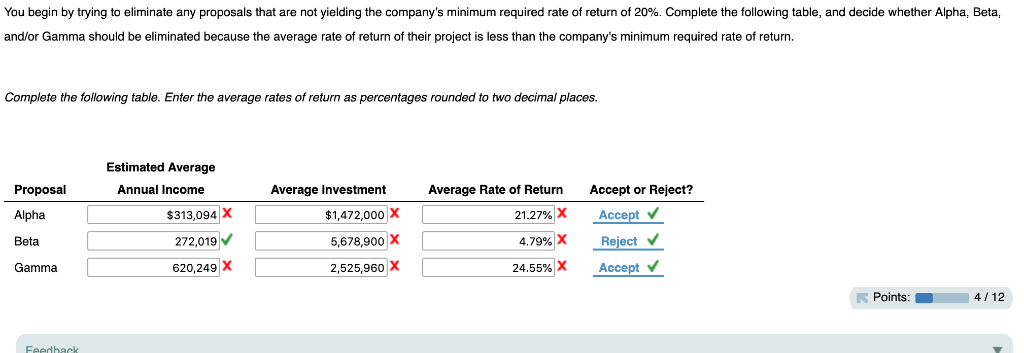






Proposal Type of Floor Plan Initial Cost if Selected Residual Value Alpha Very open, like an indoor farmer's market $1,472,000 $0.00 Beta 5,678,900 0.00 Standard grocery shelving and layout, minimal aisle space Mix of open areas and shelving areas Gamma 2,325,760 0.00 have computed estimates of annual cash flows and average annual income from customers for each of the three contractors' plans. You believe that the annual cash flows will be equal each of the 10 years for which you are preparing your capital investment analysis. Your conclusions are presented in the following table. Estimated Average Annual Income (after depreciation) Estimated Average Annual Cash Flow Proposal Alpha $302,054 $351,145 Beta 489,805 272,019 571,090 Gamma 654,469 Compare methods of capital investment analysis in the following table to begin your evaluation of the three capital investment proposals Alpha, Beta, and Gamma. You decide to compare four methods: the average rate of return, cash payback period, net present value, and internal rate of return methods. Average Rate of Return Method Cash Payback Method Net Present Value Method Internal Rate of Return Method Considers the time value of money. Does not consider the time value of money Easy to compute Not as easy to compute Directly considers expected cash flows Directly considers timing of expected cash flows Assumes cash flows can be reinvested at minimum desired rate of return Can be used to rank proposals even if project lives are not the same Net Present Value Shaded cells have feedback. Even though you're fairly certain that your evaluation and elimination is correct, you would like to compare the three proposals using the net present value method, and get some data about the internal rate of return of the proposals, each of which are expected to generate their respective annual net cash inflows for a period of 10 years. Compute the net present value of each proposal. You may need the following partial table of factors for present value of an annuity of $1. Enter amounts that represent cash outflows as negative numbers using a minus sign. Round the present value of annual net cash flows to the nearest dollar. Present Value of an Annuity of $1 at Compound Interest (Partial Table) Year 10% 20% 0.909 0.833 3.791 2.991 - 10 6.145 4.192 Alpha Beta Gamma Annual net cash flow Alpha Beta Gamma Annual net cash flow Present value factor Present value of annual net cash flows $ Amount to be invested Net present value $ Proposal Type of Floor Plan Initial Cost if Selected Residual Value Alpha Very open, like an indoor farmer's market $1,472,000 $0.00 Beta 5,678,900 0.00 Standard grocery shelving and layout, minimal aisle space Mix of open areas and shelving areas Gamma 2,325,760 0.00 have computed estimates of annual cash flows and average annual income from customers for each of the three contractors' plans. You believe that the annual cash flows will be equal each of the 10 years for which you are preparing your capital investment analysis. Your conclusions are presented in the following table. Estimated Average Annual Income (after depreciation) Estimated Average Annual Cash Flow Proposal Alpha $302,054 $351,145 Beta 489,805 272,019 571,090 Gamma 654,469 Compare methods of capital investment analysis in the following table to begin your evaluation of the three capital investment proposals Alpha, Beta, and Gamma. You decide to compare four methods: the average rate of return, cash payback period, net present value, and internal rate of return methods. Average Rate of Return Method Cash Payback Method Net Present Value Method Internal Rate of Return Method Considers the time value of money. Does not consider the time value of money Easy to compute Not as easy to compute Directly considers expected cash flows Directly considers timing of expected cash flows Assumes cash flows can be reinvested at minimum desired rate of return Can be used to rank proposals even if project lives are not the same Net Present Value Shaded cells have feedback. Even though you're fairly certain that your evaluation and elimination is correct, you would like to compare the three proposals using the net present value method, and get some data about the internal rate of return of the proposals, each of which are expected to generate their respective annual net cash inflows for a period of 10 years. Compute the net present value of each proposal. You may need the following partial table of factors for present value of an annuity of $1. Enter amounts that represent cash outflows as negative numbers using a minus sign. Round the present value of annual net cash flows to the nearest dollar. Present Value of an Annuity of $1 at Compound Interest (Partial Table) Year 10% 20% 0.909 0.833 3.791 2.991 - 10 6.145 4.192 Alpha Beta Gamma Annual net cash flow Alpha Beta Gamma Annual net cash flow Present value factor Present value of annual net cash flows $ Amount to be invested Net present value $













